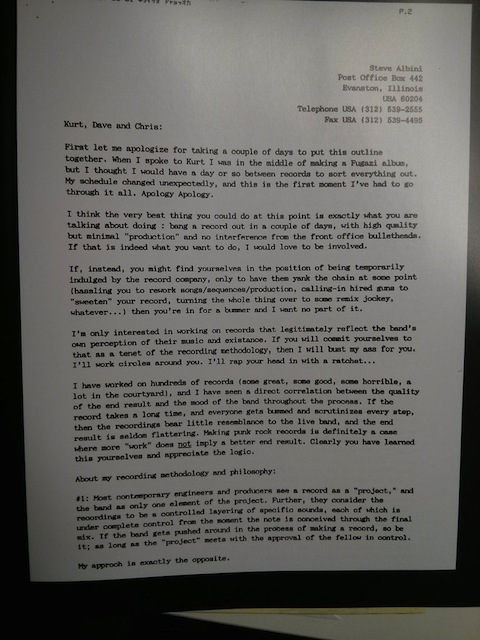[Most Recent Entries] [Calendar View]
Thursday, May 9th, 2024
| Time | Event |
| 4:42a | Read the Uncompromising Letter That Steve Albini (RIP) Wrote to Nirvana Before Producing In Utero (1993) Today, Steve Albini, the musician and producer of important albums by Nirvana, PJ Harvey, the Pixies and many others, passed away in Chicago, at the all-too-early age of 61. In tribute, we’re bringing you this classic 2013 post from our archive. Journeyman record producer Steve Albini (he prefers to be called a “recording engineer”) is perhaps the crankiest man in rock. This is not an effect of age. He’s always been that way, since the emergence of his scary, no-frills post-punk band Big Black and later projects Rapeman and Shellac. In his current role as elder statesman of indie rock and more, Chicago’s Albini has developed a reputation as kind of a hardass. He’s also a consummate professional who musicians want to know and work with. From the sound of the Pixies’ Surfer Rosa to Joanna Newsom’s Ys, Albini has had a hand in some of the defining albums of the last thirty plus years, and there is good reason for that: nothing sounds like an Albini record. His method is all his own, and his results—minimalist, dynamic, and raw—are impossible to argue with. So when Nirvana embarked on recording their final, painful (in hindsight) album In Utero, they asked Albini to steer them away from the more major-label sound of the breakout Nevermind, produced by Butch Vig. True to form, the typically verbose Albini sent a four-page typed letter in response. The letter (first page above—see the rest here) is a testament to perhaps the most thoughtful producer since Quincy Jones and lays out Albini’s philosophy in very fine detail. Two sample paragraphs serve as a thesis: I’m only interested in working on records that legitimately reflect the band’s own perception of their music and existence. If you will commit yourselves to that as a tenet of the recording methodology, then I will bust my ass for you. I’ll work circles around you. I’ll rap your head with a ratchet… I have worked on hundreds of records (some great, some good, some horrible, a lot in the courtyard), and I have seen a direct correlation between the quality of the end result and the mood of the band throughout the process. If the record takes a long time, and everyone gets bummed and scrutinizes every step, then the recordings bear little resemblance to the live band, and the end result is seldom flattering. Making punk records is definitely a case where more “work” does not imply a better end result. Clearly you have learned this yourselves and appreciate the logic. Albini decries any interference from the “front office bulletheads,” or record company execs (his feuds with such people are legendary), and makes it quite clear that he’s there to serve the interests of the band and their sound, not the product of a marketing campaign. While Albini has issued many a surly manifesto over the years, this statement of his craft is maybe the most comprehensive. He is driven by what he calls a “kinship” with the bands he works with. And his passionate commitment to musicians and to quality sound makes him one of the most artistically virtuous people working in popular music today. For more on In Utero, read Dave Grohl’s Rolling Stone interview here. Below, see Dave Grohl, Krist Novoselic and Steve Albini discuss the now-famous letter to Nirvana. Related Content: An Awkward/NSFW Interview with Nirvana Producer Steve Albini (Plus B‑52 Frontman Fred Schneider) Visit “Mariobatalivoice,” the Cooking Blog by Steve Albini, Musician & Record Producer Josh Jones is a writer and musician based in Durham, NC. Follow him at @jdmagness |
| 9:00a | Watch an Enthusiast Drive the First Car Ever Made, the 1885 Mercedes Benz In 1885, Karl Benz built what’s now considered the first modern automobile. According to the Mercedes Benz website, the car featured a “compact high-speed single-cylinder four-stroke engine installed horizontally at the rear, a tubular steel frame … and three wire-spoked wheels. The engine output was 0.75 hp (0.55 kW).” Two years after its invention, Karl Benz’s wife Bertha proved that the car was ready for prime time, driving her early Benz from Mannheim to Pforzheim. After that groundbreaking drive, the Benz went into production, becoming the first commercially available automobile in history. Above, you can watch a car enthusiast known as “Mr. Benz” take the nineteenth-century car for a spin. Below, watch a re-enactment of Bertha’s historic drive. Related Content 178,000 Images Documenting the History of the Car Now Available on a New Stanford Web Site A Flying Car Took to the Skies Back in 1949: See the Taylor Aerocar in Action
|
| << Previous Day |
2024/05/09 [Calendar] |
Next Day >> |



